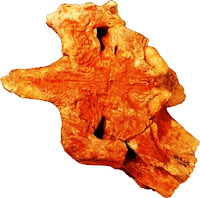 |
| Shieldcroc Artist (missouri.edu) |
 |
| Shieldcroc skull (missouri.edu) |
Holliday identified Shieldcroc by studying a fossilized partial skull specimen, which was discovered in Morocco and held by the Royal Ontario Museum of Toronto for several years before Holliday analyzed it. By analyzing blood vessel scarring on the bone, Holliday determined that the crocodile would have had a structure on top of its head, resembling a shield. The dents and bumps on the bone indicate veins delivered blood to a circular mound of skin, something never before seen in a crocodile. He said the shield was likely used as a display structure to attract mates and intimidate enemies and possibly as a thermo-regulator to control the temperature of the animal’s head.
 |
| Holliday (missouri.edu) |
“We believe Shieldcroc may have used its long face as a fish trap,” said co-author Nick Gardner, an undergraduate researcher at Marshall University, who collaborated with Holliday on the study. “It is possible that it lay in wait until an unsuspecting fish swam in front of it. Then, if it was close enough, Shieldcroc simply opened its mouth and ate the fish without a struggle, eliminating the need for strong jaws.”
A University of Missouri researcher has identified a new species of prehistoric crocodile. The extinct creature, nicknamed “Shieldcroc” due to a thick-skinned shield on its head, is an ancestor of today’s crocodiles. Its discovery provides scientists with additional information about the evolution of crocodiles and how scientists can gain insight into ways to protect the species’ environment and help prevent extinction.
In addition, Holliday analyzed Shieldcroc’s skull and brain to estimate the overall size of the reptile. He said scientists often use head size of an animal to estimate its total length. Using several parameters, Holliday and Gardner estimate that this specimen had a 5-foot long head and was 30 feet long.
“Scientists often estimate body size of crocodilians based on the size of the skull,” Gardner said. “However, estimating the body size of Shieldcroc was difficult, due to the enormous size of the skull compared to other crocodilians. To make a size estimate, we compared several features of the bone to many different species.”
“Today’s crocodiles live in deltas and estuaries, the environments put under the most stress from human activity,” Holliday said. “By understanding how these animals’ ancestors became extinct, we can gain insight into how to protect and preserve the ecosystems vital to modern crocodiles.”
This article has edited by authors of threelas
Source: http://munews.missouri.edu/news-releases/2012/0131-new-species-of-ancient-crocodile-ancestor-of-today%E2%80%99s-species-discovered-by-mu-researcher/
Publication: http://www.plosone.org/article/info%3Adoi%2F10.1371%2Fjournal.pone.0030471

Post a Comment